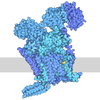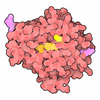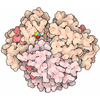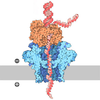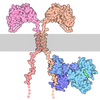+ Open data
Open data
- Basic information
Basic information
| Entry | Database: PDB / ID: 9m5p | ||||||
|---|---|---|---|---|---|---|---|
| Title | I-type amyloid fibril (40) of Tottori (D7N) mutant | ||||||
 Components Components | Amyloid-beta protein 40 | ||||||
 Keywords Keywords | PROTEIN FIBRIL / Amyloid | ||||||
| Function / homology |  Function and homology information Function and homology informationamyloid-beta complex / negative regulation of presynapse assembly / cytosolic mRNA polyadenylation / collateral sprouting in absence of injury / microglia development / regulation of Wnt signaling pathway / synaptic assembly at neuromuscular junction / Formyl peptide receptors bind formyl peptides and many other ligands / regulation of synapse structure or activity / axo-dendritic transport ...amyloid-beta complex / negative regulation of presynapse assembly / cytosolic mRNA polyadenylation / collateral sprouting in absence of injury / microglia development / regulation of Wnt signaling pathway / synaptic assembly at neuromuscular junction / Formyl peptide receptors bind formyl peptides and many other ligands / regulation of synapse structure or activity / axo-dendritic transport / axon midline choice point recognition / smooth endoplasmic reticulum calcium ion homeostasis / astrocyte activation involved in immune response / NMDA selective glutamate receptor signaling pathway / mating behavior / regulation of spontaneous synaptic transmission / ciliary rootlet / Golgi-associated vesicle / PTB domain binding / Lysosome Vesicle Biogenesis / Insertion of tail-anchored proteins into the endoplasmic reticulum membrane / positive regulation of amyloid fibril formation / neuron remodeling / Deregulated CDK5 triggers multiple neurodegenerative pathways in Alzheimer's disease models / nuclear envelope lumen / COPII-coated ER to Golgi transport vesicle / suckling behavior / signaling receptor activator activity / dendrite development / modulation of excitatory postsynaptic potential / TRAF6 mediated NF-kB activation / presynaptic active zone / positive regulation of protein metabolic process / Advanced glycosylation endproduct receptor signaling / The NLRP3 inflammasome / neuromuscular process controlling balance / negative regulation of long-term synaptic potentiation / regulation of multicellular organism growth / transition metal ion binding / intracellular copper ion homeostasis / regulation of presynapse assembly / negative regulation of neuron differentiation / ECM proteoglycans / spindle midzone / positive regulation of T cell migration / smooth endoplasmic reticulum / Purinergic signaling in leishmaniasis infection / forebrain development / positive regulation of chemokine production / clathrin-coated pit / Notch signaling pathway / positive regulation of G2/M transition of mitotic cell cycle / protein serine/threonine kinase binding / extracellular matrix organization / neuron projection maintenance / Mitochondrial protein degradation / ionotropic glutamate receptor signaling pathway / response to interleukin-1 / positive regulation of mitotic cell cycle / cholesterol metabolic process / axonogenesis / positive regulation of calcium-mediated signaling / platelet alpha granule lumen / adult locomotory behavior / positive regulation of glycolytic process / dendritic shaft / central nervous system development / learning / positive regulation of interleukin-1 beta production / trans-Golgi network membrane / positive regulation of long-term synaptic potentiation / endosome lumen / locomotory behavior / astrocyte activation / Post-translational protein phosphorylation / positive regulation of JNK cascade / microglial cell activation / serine-type endopeptidase inhibitor activity / regulation of long-term neuronal synaptic plasticity / synapse organization / TAK1-dependent IKK and NF-kappa-B activation / positive regulation of non-canonical NF-kappaB signal transduction / visual learning / neuromuscular junction / recycling endosome / positive regulation of interleukin-6 production / Golgi lumen / cognition / neuron cellular homeostasis / positive regulation of inflammatory response / endocytosis / Regulation of Insulin-like Growth Factor (IGF) transport and uptake by Insulin-like Growth Factor Binding Proteins (IGFBPs) / cellular response to amyloid-beta / neuron projection development / G2/M transition of mitotic cell cycle / positive regulation of tumor necrosis factor production / apical part of cell / synaptic vesicle / cell-cell junction / Platelet degranulation Similarity search - Function | ||||||
| Biological species |  Homo sapiens (human) Homo sapiens (human) | ||||||
| Method | ELECTRON MICROSCOPY / helical reconstruction / cryo EM / Resolution: 3.3 Å | ||||||
 Authors Authors | Burton-Smith, R.N. / Murata, K. | ||||||
| Funding support |  Japan, 1items Japan, 1items
| ||||||
 Citation Citation |  Journal: ACS Chem Neurosci / Year: 2025 Journal: ACS Chem Neurosci / Year: 2025Title: Microgravity-Assisted Exploration of the Conformational Space of Amyloid β Affected by Tottori-Type Familial Mutation D7N. Authors: Maho Yagi-Utsumi / Saeko Yanaka / Raymond N Burton-Smith / Chihong Song / Christian Ganser / Chiaki Yamazaki / Haruo Kasahara / Toru Shimazu / Takayuki Uchihashi / Kazuyoshi Murata / Koichi Kato /  Abstract: The amyloid β (Aβ) Tottori variant (D7N) exhibits unique aggregation behaviors and altered fibril formation, posing challenges for structural characterization. To overcome this, the microgravity ...The amyloid β (Aβ) Tottori variant (D7N) exhibits unique aggregation behaviors and altered fibril formation, posing challenges for structural characterization. To overcome this, the microgravity environment on the International Space Station was employed to study Tottori-type Aβ40 fibril formation and structure. Under Earth gravity, Tottori-type Aβ40 primarily formed nonfibrillar aggregates, hindering detailed structural analysis. In contrast, microgravity significantly enhanced fibril formation and minimized amorphous aggregates. Cryo-electron microscopy revealed two structurally distinct fibril types, each comprising different protomer conformations. In both types, the N-terminal segment was disordered and nor resolved in the density maps. The D7N mutation disrupts the protection of the core by the N-terminal segment often observed in wild-type Aβ40 fibrils, enhancing the hydrophobicity-mediated aggregation propensity. However, microgravity suppressed kinetic traps and facilitated high-quality fibril formation suitable for structural studies that can explore the free energy landscape of Aβ fibril formation. These findings demonstrate the utility of microgravity for studying familial Aβ variants and potentially accelerate our understanding of Aβ aggregation mechanisms in Alzheimer's disease. | ||||||
| History |
|
- Structure visualization
Structure visualization
| Structure viewer | Molecule:  Molmil Molmil Jmol/JSmol Jmol/JSmol |
|---|
- Downloads & links
Downloads & links
- Download
Download
| PDBx/mmCIF format |  9m5p.cif.gz 9m5p.cif.gz | 60.8 KB | Display |  PDBx/mmCIF format PDBx/mmCIF format |
|---|---|---|---|---|
| PDB format |  pdb9m5p.ent.gz pdb9m5p.ent.gz | 35.4 KB | Display |  PDB format PDB format |
| PDBx/mmJSON format |  9m5p.json.gz 9m5p.json.gz | Tree view |  PDBx/mmJSON format PDBx/mmJSON format | |
| Others |  Other downloads Other downloads |
-Validation report
| Summary document |  9m5p_validation.pdf.gz 9m5p_validation.pdf.gz | 727.6 KB | Display |  wwPDB validaton report wwPDB validaton report |
|---|---|---|---|---|
| Full document |  9m5p_full_validation.pdf.gz 9m5p_full_validation.pdf.gz | 727.2 KB | Display | |
| Data in XML |  9m5p_validation.xml.gz 9m5p_validation.xml.gz | 24.5 KB | Display | |
| Data in CIF |  9m5p_validation.cif.gz 9m5p_validation.cif.gz | 33.3 KB | Display | |
| Arichive directory |  https://data.pdbj.org/pub/pdb/validation_reports/m5/9m5p https://data.pdbj.org/pub/pdb/validation_reports/m5/9m5p ftp://data.pdbj.org/pub/pdb/validation_reports/m5/9m5p ftp://data.pdbj.org/pub/pdb/validation_reports/m5/9m5p | HTTPS FTP |
-Related structure data
| Related structure data |  63646MC  9m5qC  9m5rC  9umhC M: map data used to model this data C: citing same article ( |
|---|---|
| Similar structure data | Similarity search - Function & homology  F&H Search F&H Search |
- Links
Links
- Assembly
Assembly
| Deposited unit | 
|
|---|---|
| 1 |
|
- Components
Components
| #1: Protein/peptide | Mass: 4334.867 Da / Num. of mol.: 6 / Source method: isolated from a natural source / Source: (natural)  Homo sapiens (human) / References: UniProt: P05067 Homo sapiens (human) / References: UniProt: P05067Has protein modification | N | |
|---|
-Experimental details
-Experiment
| Experiment | Method: ELECTRON MICROSCOPY |
|---|---|
| EM experiment | Aggregation state: HELICAL ARRAY / 3D reconstruction method: helical reconstruction |
- Sample preparation
Sample preparation
| Component | Name: I-shaped amyloid fiber (40) of Tottori (D7N) mutant / Type: COMPLEX / Entity ID: all / Source: NATURAL |
|---|---|
| Source (natural) | Organism:  Homo sapiens (human) Homo sapiens (human) |
| Buffer solution | pH: 8 |
| Specimen | Embedding applied: NO / Shadowing applied: NO / Staining applied: NO / Vitrification applied: YES |
| Vitrification | Cryogen name: ETHANE |
- Electron microscopy imaging
Electron microscopy imaging
| Experimental equipment |  Model: Titan Krios / Image courtesy: FEI Company |
|---|---|
| Microscopy | Model: TFS KRIOS |
| Electron gun | Electron source:  FIELD EMISSION GUN / Accelerating voltage: 300 kV / Illumination mode: FLOOD BEAM FIELD EMISSION GUN / Accelerating voltage: 300 kV / Illumination mode: FLOOD BEAM |
| Electron lens | Mode: BRIGHT FIELD / Nominal defocus max: 1200 nm / Nominal defocus min: 800 nm |
| Image recording | Electron dose: 50 e/Å2 / Film or detector model: GATAN K3 BIOQUANTUM (6k x 4k) |
- Processing
Processing
| CTF correction | Type: PHASE FLIPPING AND AMPLITUDE CORRECTION | ||||||||||||||||||||||||||||||||||||||||||||||||||||||||||||
|---|---|---|---|---|---|---|---|---|---|---|---|---|---|---|---|---|---|---|---|---|---|---|---|---|---|---|---|---|---|---|---|---|---|---|---|---|---|---|---|---|---|---|---|---|---|---|---|---|---|---|---|---|---|---|---|---|---|---|---|---|---|
| Helical symmerty | Angular rotation/subunit: 179.369 ° / Axial rise/subunit: 2.41486 Å / Axial symmetry: C1 | ||||||||||||||||||||||||||||||||||||||||||||||||||||||||||||
| 3D reconstruction | Resolution: 3.3 Å / Resolution method: FSC 0.143 CUT-OFF / Num. of particles: 36690 / Symmetry type: HELICAL | ||||||||||||||||||||||||||||||||||||||||||||||||||||||||||||
| Refine LS restraints |
|
 Movie
Movie Controller
Controller






 PDBj
PDBj






